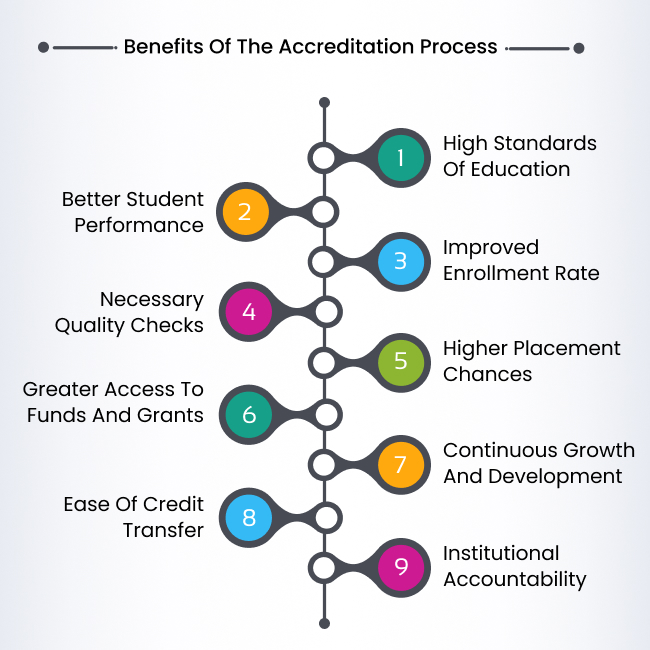08, April 2024
Students seek high-quality education and vocational training from institutes, which will help them learn new skills and knowledge. With so many institutes available and all claiming to be the best, it can be hard for students to make the ultimate decision.
Likewise, institutes struggle with quality sustenance and fail to align with set standards or benchmarks. That is why obtaining accreditation from recognised organisations is the way forward to ensure excellence in overall institutional operations. Furthermore, ADMS is the ultimate software that can streamline all the complex accreditation-related activities.
What is accreditation?
Accreditation is a quality assurance process that institutes undertake to meet academic goals and standards. Furthermore, it includes a systematic assessment of the policies, methodologies, and outcomes.
The government-recognised accrediting agencies and higher education bodies use a multi-step evaluation process. For instance, it includes site visits, self-studies, and elaborate assessments by academicians and experts.

The objective behind accreditation is to ensure that institutes maintain the criteria in the context of student support services, curriculum, etc. There are several benefits of the accreditation process; let us have a look:
1. High Standards of Education
What goes into facilitating high-quality education? This is a question that has been raised countless times over the decades. There are a lot of factors worth considering, including effective teaching and learning.
The primary reason is that outdated and well-followed pedagogies and curricula lead to ineffective learning. Students study for the sake of clearing exams and fail to gather knowledge or skills, which impacts their future negatively.
In contrast, accreditation ensures institutes carry out the necessary action plans that will help facilitate quality educational practices. It includes hiring qualified faculty and implementing policies that will safeguard the interests of students.
At the same time, the institute provides courses and programmes that are in line with the accreditation rules and principles.
UGC To Introduce Binary Accreditation System In NAAC
2. Better student performance
Does a graduation degree guarantee jobs? If studying and attaining a degree led to assured employment, then the youth would not have faced joblessness. Nonetheless, it is noteworthy to point out the primary factors.
For instance, employers and organisations prioritise skills and competency, whereas the country’s economic condition is equally vital. And this is where institutes play a critical role by educating students with appropriate methodologies.
On the other hand, accreditation provides significant guidance and resources, which are key to improving the programmes and courses. Consequently, students learn the latest skills and knowledge through experiential approaches.
Also, outcome-based education and student-centric mechanisms enable students to prosper beyond the academic sphere. They participate in different curricular and co-curricular activities that add value to their learning experience. By the time they graduate, they will have sufficient knowledge and competence to excel in their chosen fields.
3. Improved Enrollment Rate
All higher education institutes strive for success and gradual expansion, and one of their determining factors is the enrollment rate. The number of admissions per year indicates the popularity of a course or programme at a particular institute.
Simultaneously, if the courses and the educational approaches are unproductive, it leads to lower admissions. In fact, sometimes the institute has to discontinue the course because of below-average admission.
On the other hand, failing to match up with global educational standards and appropriate resources also leads to students dropping out. Meanwhile, accredited institutes are indicative of:
- High-quality educational initiatives
- State-of-the-art infrastructure
- Efficient student support services
- Dedicated faculty and departments of varied subjects
Consequently, students from various socio-economic and cultural backgrounds take admission to institutes that have such faculties. Institutes achieve a higher enrollment rate and succeed in establishing a diverse student community.
4. Necessary quality checks
Why is there such a vast difference between students’s performance in the last two years? What is the enrollment rate decreasing? What is the most useful assessment technique?
Addressing and answering these questions is essential because it allows institutes to figure out their shortcomings. The accreditation process motivates institutes to carry out quality checks for all their major or minor procedures.
In fact, it helps them figure out specific procedures that have been instrumental in driving students’s learning outcomes. At the same time, using tools like college ERP during the accreditation process helps identify areas for improvement.
What’s more, they can track the ongoing progress of students and streamline academic reports. Also, teachers can implement appropriate strategies to elevate students’s competencies. Therefore, it is hardly surprising that students and parents prefer and trust such institutes that cater to students’s needs.
5. Higher placement chances
Colleges and universities conduct employment and placement camps on campus every academic year. Industry experts, top company representatives, and recruiters take part in such events, allowing students to engage with them.
In addition, it allows them to understand the current job market and determine the in-demand skills that companies prefer. On the other hand, organisations strive to recruit skilled graduates from accredited institutes.
One of the main reasons is that students from such institutes have relevant competencies as they learn through outcome-based education.
6. Greater Access to Funds and Grants
The UGC has issued the Fitness of Colleges for Receiving Grants Rule 2024, according to which institutes must hold valid accreditation. They can apply for accreditation from either the NAAC or NBAfor 60 percent of their eligible programmes.
Besides, accreditation leads to funding opportunities and grants that benefit both students and institutes. Also, getting grants enables students to improve their infrastructure, implement modern and appropriate pedagogies, and use better instructional methods.
Moreover, it reflects an institution’s credibility, increasing its likelihood of securing scholarships, grants, and collaborations with industry partners.
Complete Guide To The National Board Of Accreditation (NBA Accreditation)
7. Continuous Growth and Development
An educational institution is a dynamic entity that is conducive to both negative and positive changes throughout the academic year. However, failing to keep track of how they are impacting its overall efficiency can lead to a gradual decline.
That is why accredited institutes succeed in all areas as they undergo continuous improvement through self-assessment. Additionally, they prioritise self-reflection and institute planning to overcome obstacles and meet the set criteria.
Moreover, it is an authorization process, enabling institutes to gain feedback and insight for improvement in various areas. It motivates them to improve their core operations to cater to changing educational requirements.
8. Ease of Credit Transfer
The credit transfer system can be quite confusing for students pursuing undergraduate or postgraduate programs. However, accredited institutes make it easier for students to transfer credits from one institute to another.
Consequently, it simplifies the mobility of students between different institutions, programmes, or countries. Simultaneously, it ensures that the new institute recognises and validates proper learning and academic achievements.
9. Institutional Accountability
Institutional accountability and transparency are two byproducts of the evaluation process that benefit the institutes. Also, it ensures that they follow ethical practices and fulfil their responsibilities towards students and society.
Therefore, a robust tool like ADMS is an ideal assistive technological solution that enables colleges and universities to streamline the accreditation process. Meanwhile, they are accountable to stakeholders, including accrediting agencies, students, and the general public.
To wrap it up,
The accreditation process is a complex procedure of quality assurance that enhances the institute’s reputation and enrollment rate. It is a significant process that facilitates global recognition and institutional accountability.
Accredited institutions strive for excellence and succeed in the higher education field through continuous improvement and quality sustenance.
Achieve institutional excellence and streamline the accreditation process with MasterSoft’s ADMS
Mobile: 08448010216
Email:info@mastersofterp.com












